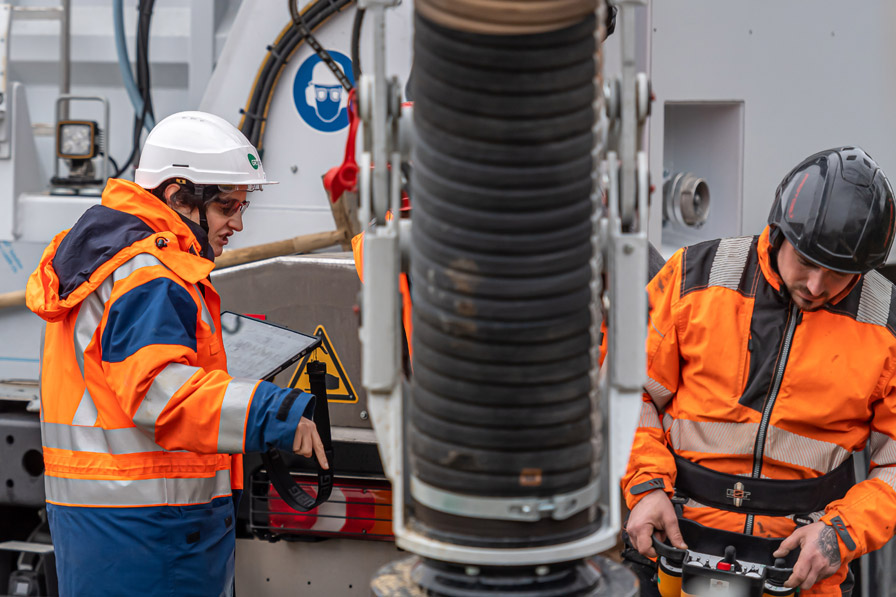GRTgaz safety actions

GRTgaz’s network is made up of compressor stations, pressure reduction stations and pipelines that GRTgaz designs, constructs, operates and maintains.
GRTgaz’s safety policy covers all these steps. It sets the regulations and procedures that govern its day-to-day activities.
A formalised safety policy
GRTgaz’s Safety and Industrial Safety commitments describe the actions taken towards “Our collective safety and industrial safety goals”. They outline the actions aimed at managing risks linked to industrial safety and the health and safety of people.
To guarantee the safety of people, GRTgaz supports employees on the ground, including a yearly individual “safety” inspection. The aim is to promote good practices and identify any difficulties. GRTgaz also trains its managers in holding these inspections. Technical supervisions help spread a culture of industrial safety within the company.
GRTgaz gives the same weight to the safety of companies working on its behalf as it does on its own employees.
This safety policy is continually being adapted to changes in GRTgaz’s network and working conditions. Hazard studies are updated at least once every five years. Likewise, general management and the regional directorates and business lines are engaged in an ongoing process of improvement.
Digital support for the network
The whole network is managed in real time via sensors, equipment and dynamic simulation tools. GRTgaz ensures the proper working of the gas transmission network via sensors fitted to the industrial facilities. These transmit data at regular intervals or, according to their programming, when a threshold is breached (vibration, temperature, pressure).
Implementing predictive maintenance
GRTgaz also uses to data to develop predictive maintenance. This process has a number of aims, including anticipating failures on the network, reducing costs, maintaining performance and avoiding unnecessary interventions.
GRTgaz’s teams of data scientists are now putting concrete actions into effect. Their challenge is to analyse the data collected as part of GRTgaz’s monitoring operations using a combination of AI and big data technologies.
Controlling third-party works near to the network
For GRTgaz, ensuring the safety of residents and companies working near to our pipelines involves handling all declarations for all earth-moving works near to the network, in accordance with the regulations in force.
This requires that the manager of the company carrying out the works inquires as to the presence of GRTgaz networks near to their project. If networks are present, the manager must then declare the works the using the dedicated “single service point”.
This procedure is carried out via a “single service point” that gathers the details of all network operators. GRTgaz teams systematically head out to the declared sites to mark out the pipelines and inform the works managers about the safety instructions they must comply with.
Titre
Toolbox and useful links
Advanced network monitoring
GRTgaz manages and monitors the proper workings of its networks around the clock via sensors located throughout the network that continually update the four regional monitoring centres.
Pipelines are also monitored by land, road and air to detect any works that have not complied with the regulatory obligation to declare.
GRTgaz is planning and testing the use of drones to inspect and maintain the pipelines over long distances, or for so-called “non-standard” sections. Tests are also being carried out on methane detection by helicopter.
Augmented reality based on accurate mapping is also being tested by RICE, GRTgaz’s R&D department, to visualise buried networks. The aim is to make recommendations for excavation works by public companies even more salient, in particular in congested underground areas.
Controls and inspection to guarantee the condition of the network
GRTgaz inspects the whole of its transmission network every 10 years using instrumented pigs fitted with sensors and fault detectors. This includes the ongoing control of compression engines and the accurate monitoring of their performance, in close contact with the manufacturers.
GRTgaz reviews its hazard studies every five years to take account of the changing levels of urbanisation surrounding its pipelines and to implement offsetting measures, if necessary.
Phases of a safe earth-moving worksite on GRTgaz facilities - french version only
Cybersecurity
Cybersecurity is an integral part of GRTgaz’s core purpose. It involves adapting and changing to combat the ever-present risks and the protean nature of cyber threats. Protecting the availability, integrity and confidentiality of GRTgaz’s data and that of its customers is a key security challenge.
To meet this challenge, GRTgaz has committed to building and managing a cyber-defence strategy via its Governance and Cyber Operations teams.
The strategy is centred on the company’s Computer Emergency Response Team (CERT) comprised of experts in preventing, detecting and responding to security incidents.
CERT is tasked with:
- Prevention: identifying vulnerabilities and drawing up a remediation plan.
- Detection: recognising suspicious behaviour and analysing alerts.
- Response: performing a digital investigation, then drawing up and applying a plan to react to, communicate about and manage the crisis in a way that restores the service and limits the impacts.

